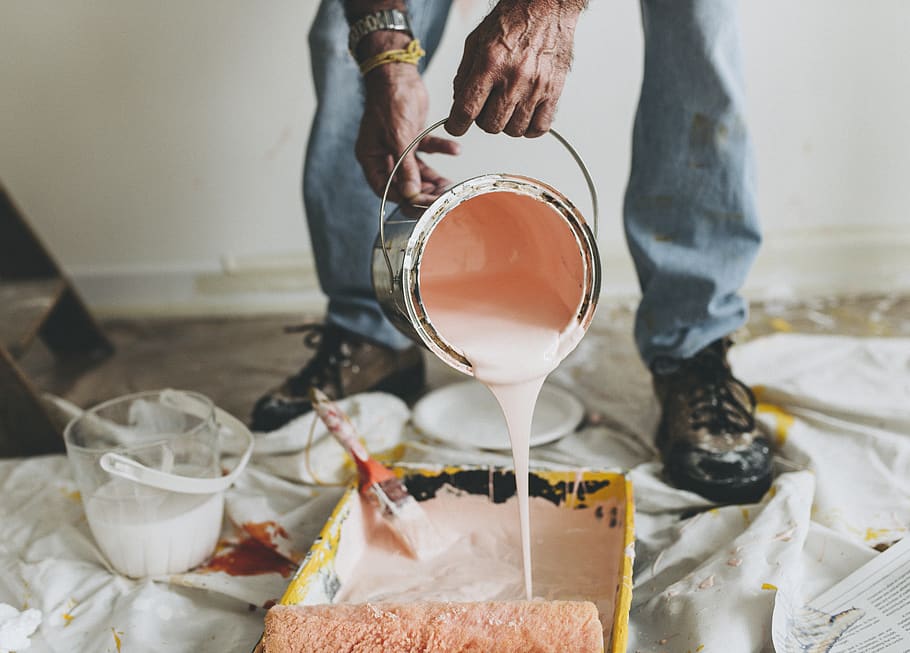How to Paint With a Roller

If you have to paint large wall expanses or ceiling area., then it is always a good idea to use a paint roller. It is one of the best ways to paint quickly and even finish. The tools required for painting using roller are easy, cleaning is easy, and the set-up is also easy as compared to other techniques like spray painting.
However, painting with a roller is not as easy as it sounds. Now you must be wondering how to paint with a roller? Or how to use a paint roller?
Relax! You need not worry. Here are some tips for painting with a roller in order to help you regarding the same.
One tip to complete the painting work quickly is to use a screen and bucket instead of using a line and a paint tray.
During large jobs, professionals avoid putting several gallons of paint in a single bucket.
They press out excess paint on the bucket screen that is attached to the bucket. It helps in accelerating the speed of painting because you do need to visit repeatedly to the paint tray.
Metrics of the Project
| Total Time – 1 day Working Time – 4 hours are needed for a room with a size of 150 square foot Cost of Materials – $30 to $80 Skill Level – Beginner |
Required Materials
| Roller cover of size 9-inch Roller frame of size 9-inch A five-gallon bucket that is properly cleaned Five-gallon steel of plastic or steel Plastic sheeting Drop cloth | Extension pole Painter’s tape Paint stirring stick made of wood Metal spiral power mixer Nitrile or latex gloves Interior latex paint |
Instructions to Paint Using a Roller

RELATED: How to Texture a Wall With a Roller
Prepare the Area of Painting
Remove small items like side tables, area rugs, and chairs from the room you are planning to paint.
Properly lay the drop in the painting area.
Use a plastic sheet to cover all the items that you can not remove and secure the plastic with the help of the painter’s tape.
Prepare the Edges of Painting Area
When you paint using a roller, it is not a good idea to paint against the edges directly.
If you directly paint along the edges in the room, it will restrict you from attaining a razor-sharp line. Instead, it would be better to paint the edge prior to rolling.
In order to paint the edges, you should use a paint edger, which is a small tool used for painting the portion along the edges.
Another method that you can use is the painter’s tape.
All you need to do is run the tape along the surface that you don’t want to paint. It saves the surface from getting painted.
Mix the Paint Properly
Paint consensus solids and pigments that get separated if the paint is still for a longer time. Therefore you should mix the paint thoroughly using a power mixer that is attached to the drill.
You do not need to thin the fresh paint that is applied using a roller or brush.
In case you have different paint cans of the same color, then it is better to combine the paint in a common bucket.
Transfer the Paint to the Bucket
You should always pour the paint into a five-gallon paint bucket.
Use a pouring spout to fit the paint can and then tip, so the paint flows properly and slowly into the bucket.
PRO TIP
You should not pour fast, as it can lead to the creation of bubbles in the paint. Do not pour more than three gallons initially. More than this amount would envelop the screen of the bucket, which will make it difficult to use.
Below mentioned are some benefits of using a bucket.

- You can easily move the bucket without spilling the paint.
- More paint can be held in the bucket, so you will not have to refill the pan frequently.
- It is easy to load the cover with paint from a bucket.
- You can easily cover the bucket using a damp clop in order to avoid the paint from drying while you are taking a break.
Hook the Bucket Screen
Add the bucket screen on the lip of the paint bucket.
The bucket screen would extend around a few inches into the bucket, and a major part of this screen would be visible above the paint.
In case the usable screen that you have is less than 9 inches, then it would be better to pour back some paint into the can.
Soak the Paint Roller Cover in the Paint

Dip the roller cover in the paint bucket. Do not dip it beyond the cover of the roller as it would result in drips. Allow the roller cover to soak the paint completely. After this move, the roller covers to the top of the screen and then roll it downwards several times.
PRO TIP
Do not press it too hard, as it will lead to the formation of pronounced grid marks on the wall. These marks would be difficult to smooth out.
Paint the Main Surface Area
The next step is to begin the process of rolling the main area using a sufficiently dry paint roller.
You should remain in the local areas around 4 feet by 4 feet and should move the roller in W-pattern.
In order to avoid the creation of lines, you should keep rolling off of a wet edge.
You should reload the roller cover when the marks of roll start looking hazy and spotty.
In order to equalize the paint that is present on the cover, it is better to dip the roller multiple times in the paint bucket.
Paint Close to the Edges
The next step is to roll the cover close to the edges.
Assuming that you have painted the edges previously, you might have a band of paint at a width of several inches.
You should meet the band using your paint roller. A good paint edger can help paint the edges.
Roll a Second Coat
Once the paint is dried completely, you should apply a second coat of paint. It is better to apply two or more coats of paint as it will help in deepening the color.
Clean the Area of Work
After the paint has dried, the next step is to remove the painter’s tape.
In case you have used latex paint, you should clean the roller frame, bucket, brushes, bucket screen, and the other tools that you have used.
You should clean the items using warm water and soap.
Tips for Painting with a Roller

Below mentioned are some tips for painting with a roller so that you end up painting the wall perfectly.
- You should be careful while rolling close to the surface that is non-painted like the ceiling. If you do not paint carefully, you might splatter some drop of paint on the surface. In order to avoid splattering the paint, you should roll slowly.
- It is difficult to clean the roller cover. Therefore, it is better to discard the roller cover after using it and use a fresh one when you paint the next time.
- You should turn off air conditioning or heat while the coat of paint is wet. It will help in keeping the dust to stick on the wet paint.






